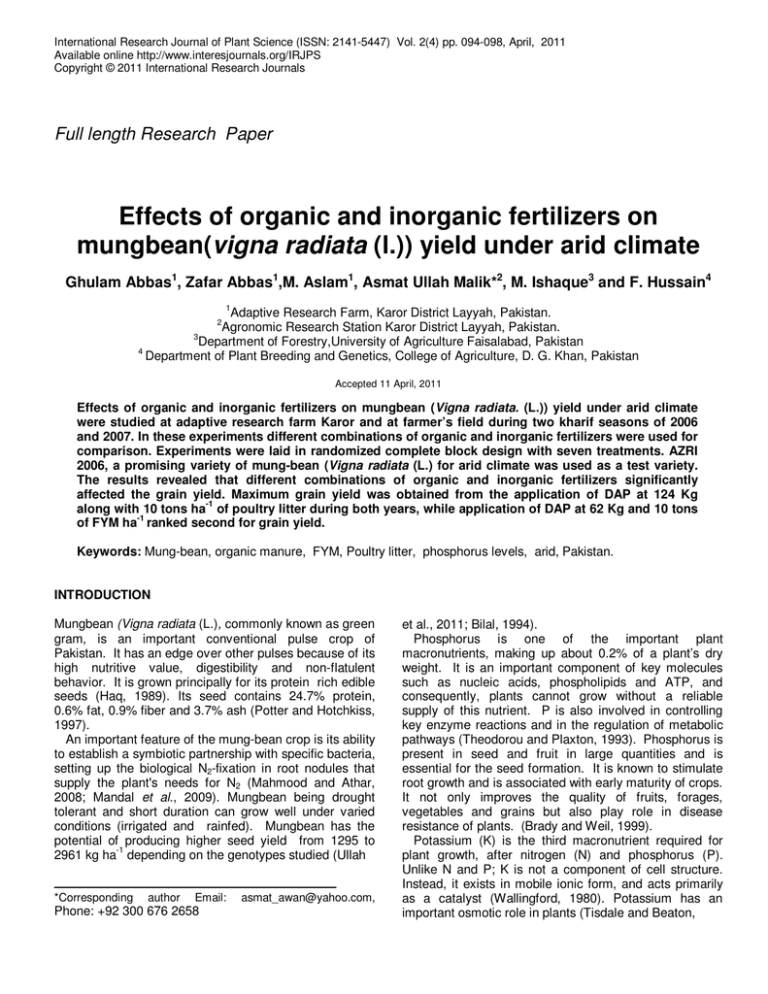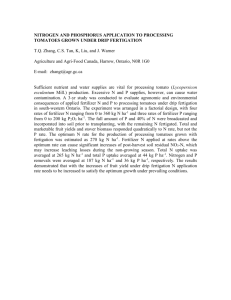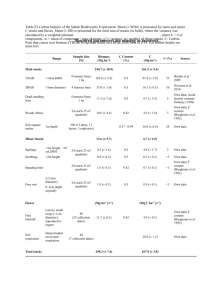Document 14258144
advertisement

International Research Journal of Plant Science (ISSN: 2141-5447) Vol. 2(4) pp. 094-098, April, 2011 Available online http://www.interesjournals.org/IRJPS Copyright © 2011 International Research Journals Full length Research Paper Effects of organic and inorganic fertilizers on mungbean(vigna radiata (l.)) yield under arid climate Ghulam Abbas1, Zafar Abbas1,M. Aslam1, Asmat Ullah Malik*2, M. Ishaque3 and F. Hussain4 1 Adaptive Research Farm, Karor District Layyah, Pakistan. Agronomic Research Station Karor District Layyah, Pakistan. 3 Department of Forestry,University of Agriculture Faisalabad, Pakistan 4 Department of Plant Breeding and Genetics, College of Agriculture, D. G. Khan, Pakistan 2 Accepted 11 April, 2011 Effects of organic and inorganic fertilizers on mungbean (Vigna radiata. (L.)) yield under arid climate were studied at adaptive research farm Karor and at farmer’s field during two kharif seasons of 2006 and 2007. In these experiments different combinations of organic and inorganic fertilizers were used for comparison. Experiments were laid in randomized complete block design with seven treatments. AZRI 2006, a promising variety of mung-bean (Vigna radiata (L.) for arid climate was used as a test variety. The results revealed that different combinations of organic and inorganic fertilizers significantly affected the grain yield. Maximum grain yield was obtained from the application of DAP at 124 Kg -1 along with 10 tons ha of poultry litter during both years, while application of DAP at 62 Kg and 10 tons -1 of FYM ha ranked second for grain yield. Keywords: Mung-bean, organic manure, FYM, Poultry litter, phosphorus levels, arid, Pakistan. INTRODUCTION Mungbean (Vigna radiata (L.), commonly known as green gram, is an important conventional pulse crop of Pakistan. It has an edge over other pulses because of its high nutritive value, digestibility and non-flatulent behavior. It is grown principally for its protein rich edible seeds (Haq, 1989). Its seed contains 24.7% protein, 0.6% fat, 0.9% fiber and 3.7% ash (Potter and Hotchkiss, 1997). An important feature of the mung-bean crop is its ability to establish a symbiotic partnership with specific bacteria, setting up the biological N2-fixation in root nodules that supply the plant's needs for N2 (Mahmood and Athar, 2008; Mandal et al., 2009). Mungbean being drought tolerant and short duration can grow well under varied conditions (irrigated and rainfed). Mungbean has the potential of producing higher seed yield from 1295 to -1 2961 kg ha depending on the genotypes studied (Ullah *Corresponding author Email: Phone: +92 300 676 2658 asmat_awan@yahoo.com, et al., 2011; Bilal, 1994). Phosphorus is one of the important plant macronutrients, making up about 0.2% of a plant’s dry weight. It is an important component of key molecules such as nucleic acids, phospholipids and ATP, and consequently, plants cannot grow without a reliable supply of this nutrient. P is also involved in controlling key enzyme reactions and in the regulation of metabolic pathways (Theodorou and Plaxton, 1993). Phosphorus is present in seed and fruit in large quantities and is essential for the seed formation. It is known to stimulate root growth and is associated with early maturity of crops. It not only improves the quality of fruits, forages, vegetables and grains but also play role in disease resistance of plants. (Brady and Weil, 1999). Potassium (K) is the third macronutrient required for plant growth, after nitrogen (N) and phosphorus (P). Unlike N and P; K is not a component of cell structure. Instead, it exists in mobile ionic form, and acts primarily as a catalyst (Wallingford, 1980). Potassium has an important osmotic role in plants (Tisdale and Beaton, Abbas et al. 095 1985) important function in arid environments for plants metabolism. Recently, the use of organic materials as fertilizers for crop production has received attention for sustainable crop productivity (Tejada et al., 2009). Organic materials hold great promise as a source of multiple nutrients and ability to improve soil characteristics (Moller, 2009). Organic farming preserves the ecosystem. Symbiotic life forms are cultured ensuring weed and pest control and optimum soil biological activity which maintain soil fertility. The synthetic fertilizers are harmful for soil and aerial environment a threat to entire globe, because the inorganic fertilizers mainly contain major nutrients NPK in large quantities and are neglecting the use of organic manures and bio-fertilizers and hence have paved the way for deterioration of soil health and in turn ill-effects on plants, human being and livestock (Choudhry, 2005). Legumes are highly responded to phosphatic fertilizer but high cost and timely availability of this fertilizer is problem. Balance use of fertilizer is important to obtain maximum seed yield. Therefore, the present study was undertaken to estimate the effect of organic and inorganic fertilizers on growth and yield of mungbean under arid climate. (124 kg DAP ha-1 Departmental Recommendation T4 (62 kg DAP ha-1 + 10 tons FYM ha-1), T5 (124 kg DAP ha-1 +10 tons FYM ha-1), T6 (62 kg DAP ha-1 + 10 tons poultry litter ha-1), and T7 = 124 kg DAP ha-1 + 10 tons poultry litter ha-1 were applied. Soil was prepared with three ploughing and two planking. Stomp a weedicide (pendimethaline) was sprayed at 2500 ml ha-1 for preemergence weeds control at the time of seedbed preparation. Organic and inorganic fertilizers were applied before sowing, at the time of seedbed preparation. Organic fertilizers were applied as farmyard manure and poultry litter. Inorganic fertilizers were applied in the form of DAP, SOP and urea. All other agronomic practices were kept same for all treatments. Mungbean variety AZRI-2006 was used as a test variety. Seed rate was used at 14 kg ha-1 according to department recommendation. Automatic drill was used for sowing purpose. First irrigation was applied at the time of flower initiation and then at the interval of fifteen days. Plant protection measures were adopted after pest scouting of insects, pests and diseases. The yield data were recorded by harvesting randomly selected 3m × 3m area from each treatment, whereas plant height and number of pods were recorded on the average of ten plants from each treatment. MATERIALS AND METHODS Statistical Analysis Soil analysis and Description of Site Adaptive Research Farm Karor (ARF), District, Layyah, which lies between 30°-45' to 31°-24' N, and 70°-44' to 71°-50'E,. The physiochemical properties of soil at a depth of 0-15cm of ARF were measured. Soil texture was loam having the following characteristics: sand (40.7%), silt (37.3%), clay (22.0%), pH (8.1), organic matter (0.8%), CaCO3 (5.5%), EC 1.5 dSm-1, available N -1 -1 0.6 g kg , available P 10.5 mg kg , exchangeable K 125 -1 mg kg and AB-DTPA extractable Zn 0.9 mg kg-1, AB-1 DTPA extractable Fe 2.9 mg kg and AB-DTPA -1 extractable Mn 1.2 mg kg . The Farm Yard Manure (FYM) was also subjected to analysis and calculated status as; Nitrogen 2.4 ppm, Phosphorus 394.2 ppm, Potassium 2838.0 ppm and organic Carbon 16.3 ppm. Experimental Lay out The experiments were conducted at ARF Karor and farmer’s fields located at Mouza Kharal Azeem, Tehsil and District Layyah and at Chak No. 598 TDA, Tehsil Kot Addu, and District. Muzaffar Garh during Kharif 2006 and 2007 cropping seasons. The experiments were laid out with seven treatments in a randomized complete block design having three replications. The seven treatments T1 (Control), T2 (62 kg DAP ha-1 Farmers practice), T3 Year wise data was subjected to statistical analysis separately by using analysis of variance technique. The difference among treatment means was compared by using least significant difference test at 5% probability level (Steel et al., 1997). RESULTS AND DISCUSSION The data on Mungbean yield was subjected to statistical analysis and significant differences were found among the treatments (Table I). Grain yield of mungbean crop is a function of cumulative effect of various yield components, which are influenced by genetic make-up of variety, various agronomic practices and environmental conditions. The mean grain yield as influenced by various fertility levels are presented in (Table I). Application of DAP at124 kg ha-1 along with 10 tons of poultry litter ha-1 (T7) -1 produced maximum grain yield (1280 and 1212 Kg ha ) -1 at ARF Karor compared to control (794.8 kg ha ). Similarly, at farmer’s field with the same above organic and inorganic fertilizer the grain yield was recorded as 1306 and1164 kg ha-1 during the years 2006-07 as -1 compared to control (834.4 Kg ha ). The combination of organic plus inorganic doses of fertilizers increased grain yield upto 52% in T7 compared to control at ARF and 99.12% at farmer’s field (Table 2 and 3). Treatment T5 096 Int. Res. J. Plant Sci. -1 Table 1. Effect of organic and inorganic fertilizers on grain yield (kg ha ) of mungbean . ARF 2007 834.4 g Farmer’s 2007 767.7 g 1006.0 c 868.9 f 805.4 f 1151.0 c 1220.0 b 967.8 c 905.6 c 1087.0 d 1006.0 c 868.9 e 828.9 e 1194.0 b 1300.0 a 1056.0 b 1008.0 b 1145.0 c 1212.0 b 944.0 d 874.7 d T7= 124 kg DAP ha-1 + 10 tons Poultry Littre ha-1 1280.0 a 1306.0 a 1212.00 a 1164.0 a LSD0.05 28.92 9.287 15.97 14.69 Treatments T1= Control T2=62 kg DAP ha-1 (Farmers’ practice) ARF 2006 794.8 f Farmer’s 2006 472.0 d 1001.0 e field field -1 T3=124 kg DAP ha (Departmental. recommendation) -1 T4= 62 kg DAP ha + 10 tons -1 FYM ha T5=124 kg DAP ha-1+10 tons -1 FYM ha -1 T6= 62 kg DAP ha + 10 tons -1 Poultry Littre ha Means sharing the same letter in a column do not differ statistically at P ≤ 0.05 by LSD test. Table 2. Economic analysis of organic and inorganic fertilizer on mungbean yield under arid climate. (Pooled data of Adaptive Research Farm 2006&2007) Mean yield (kg ha –1) Additional Yield (kg ha –1) % age Increase /Decrease T1= Control T2=62 kg DAP ha-1 (Farmers practice) 815 935 120 14.72 Total Exp. ( Rs. ) Bifurcate this coloumn and include the values of column 8&9 7475 17721 T3=124 kg DAP ha-1 (Departmental. recommendation) T4= 62 kg DAP ha-1 + 10 tons FYM ha-1 T5=124 kg DAP ha-1+10 tons FYM ha-1 T6= 62 kg DAP ha-1 + 10 tons Poultry Littre ha-1 T7= 124 kg DAP ha-1 + 10 tons Poultry Littre ha-1 1060 245 30.06 15093 35605 20512 7115 8229 1:1.15 988 173 21.22 11124 33186 22062 3515 5811 1:1.65 1125 310 38.00 14830 37788 22958 6515 10412 1:1.59 1045 230 28.22 17356 35101 17745 9411 7725 1:0.82 1246 431 52.08 14759 41853 27094 6411 14477 1:2.25 Treatments Total Income ( Rs. ) Net Income ( Rs. ) Additional Expenditure Due to treatment ( Rs. ) 8 Additional Income due to treatment ( Rs. ) 9 Cost benefit ratio (CBR) 27375 31406 19900 13685 10011 4030 1:0.40 Means sharing the same letter in a column do not differ statistically at P ≤ 0.05 by LSD test. Abbas et al. 097 Table 3. Economic analysis of organic and inorganic Fertilizer on mungbean yield under arid climate. (Pooled data of farmer’s field 2006&2007) Treatments Avg. yield (Kg –1 ha ) Additional Yield –1 (Kg ha ) % age Increase /Decrease Total Exp. ( Rs. ) Total Income ( Rs. ) Net Income ( Rs. ) Additional Expenditure Due to treatment ( Rs. ) Additional Income due to treatment ( Rs. ) Cost benefit ratio (CBR T1= Control 620 - - 7072 20825 13753 - - - T2=62 kg DAP ha-1 (Farmers practice) 905 285 45.96 17620 30398 12778 10011 9573 1:0.95 T3=124 kg DAP ha (Departmental. recommendation) -1 T4= 62 kg DAP ha + -1 10 tons FYM ha 1058 438 70.64 15060 35538 20478 7115 14712 1:2.06 917 297 47.90 11191 30802 19611 3515 9976 1:2.83 T5=124 kg DAP ha-1+10 tons FYM ha-1 T6= 62 kg DAP ha-1 + 10 tons Poultry Littre ha-1 T7= 124 kg DAP ha-1 + 10 tons Poultry Littre ha-1 1114 494 79.67 14597 37419 22822 6515 16593 1:2.54 1087 467 75.32 17423 36512 19089 9411 15686 1:1.66 1235 615 99.19 14726 41483 26757 6411 20657 1:3.22 -1 Means sharing the same letter in a column do not differ statistically at P ≤ 0.05 by LSD test. (124 kg DAP ha-1 + 10 tons FYM ha-1) ranked 2nd with the grain yield of 1194 kg ha-1, 1056 kg ha-1 at ARF and 1300 -1 -1 kg ha , 1008 kg ha at farmers field during both years 2006-2007 respectively, which showed an increase of 38% over control at A RF (Table 2) and 79.67% increase at farmer’s field (Table 3). -1 Departmental recommendation of DAP at124 kg ha rd (T3) ranked 3 with the grain yield of 1151 and 967.8 kg ha-1 at ARF and 1220 and 905.6 kg ha-1 at farmer’s field respectively during both cropping years at 2006-07 , which showed an increase of 30.06% over control at ARF (Table 2). Treatment T6 (62 Kg DAP ha-1 + 10 tons poultry litter ha-1) ranked 4th with the grain yield of 1145 Kg ha-1, 944 Kg ha-1 at AR F and 1212 kg ha-1, 874.7 kg ha-1 at farmer’s field, respectively, during both years 2006-2007, which showed 28.22% increase over control at ARF (Table 2) and 75.32% increase at farmer’s field (Table 3). Fertilizer combination 62 kg DAP ha-1 + 10 tons FYM (T4) produced the grain yield of 1087 kg ha-1, 888.9 -1 -1 -1 kg ha at ARF and 1006 kg ha , 828.9 kg ha at farmer’s field respectively, during both years 2006-07 which is 21.22% increase over control at ARF (Table 2) and 47.90% increase at farmer’s field (Table 3). -1 Treatment T2 (62 kg DAP ha ) produced the grain yield -1 -1 -1 of 1001 kg ha , 868.9 kg ha at ARF and 1006 kg ha -1 ,805.4 kg ha at farmer’s field during the both years 2006-07 which is 14.72% increase over control at ARF (Table 2) and 45.96% increase at farmer’s field (Table 3). These results are in line with that of Khan et al. 2002; Shahi, 2002 and Srinives and Shaik, 2002). These results are also confirmed the findings of Bhriguvanshi (1988) who reported that some of plant nutrients, when added to the soil in the inorganic form have low efficiency as compared with the effect of same nutrients applied along with organic manures. Thus organic manures reduce the application rate of chemical fertilizers also help to solve the problem of micronutrients deficiency in soil to produce higher grain yield. Naeem et al. (2006) observed the maximum number of -1 grains pod (12.54) with the application of NPK in variety NM-98 and (11.38) in variety M-1 and the maximum 1000-grain weight (40.86g) in treatment NPK in variety NM-98 and (40.55g) in the same variety NM-98 which was however statistically at par with variety M-1 in NPK treatment. CONCLUSION The study concluded that 124 Kg DAP ha-1 along with 10 tons of poultry litter were excellent combination for obtaining the maximum grain yield of mungbean crop. 098 Int. Res. J. Plant Sci. The farming community is advised to adapt recommendation for better production of mung-bean crop. REFERENCES Bhriguvanshi SR (1988). Enrichment of organic manures and their effect on yield and nutrients uptake by Wheat. J. Indian Soc. Soil science 36: 510-514. Bilal M (1994). Effect of sowing dates on growth and yield of three varieties of mungbean (Vigna radiata L.). MSc. Thesis. Deptt. Agron. Univ. of Agric. Faisalabad. th Brady NC, Weil RR (1999). The nature and properties of soil. 12 Ed. Macmillan Publishing Company, New York. Choudhry AU (2005). Higher-Value Organics, pp: 35–8. Pakistan and Gulf Economist Potter, N.N. and J.H. Hotchkiss. 1997. Food Science CBS Publishers, New Delhi, India pp: 403. Considine M (1982). Foods and food production, Encyclopedia. Van Nostard Book CO. pp. 173 Haq A (1989). Studies on the yield and related morphological characters of some new mungbean genotypes in irrigated environment. M.Sc. Thesis. Dept. Agronomy, Univ. Khan M., Aslam AM, Sultan T, Mahmood IA (2002). Response of phosphorous application on growth and yield of inoculated and uninoculated mungbean. Int. J. Agric Biol., 4(4): 523-524. Mahmood A, Athar M (2008). Cross inoculation studies: Response of Vigna mungo to inoculation with rhizobia from tree legumes growing under arid Environment. Int. J. Environ. Sci. Technol. 5: 135-139. Malik BA, Nazir S, Bashir E (1994). Grain legumes in crop production. National Book Foundation, Islamabad, pp: 301. Mandal S, Mandal M, Das A (2009). Stimulation of indoleacetic acid production in a Rhizobium isolate of Vigna mungo by root nodule phenolic acids. Arch. Microbiol. 191: 389-393. Moller K (2009). Influence of different manuring systems with and without biogas digestion on soil organic matter and nitrogen inputs, flows and budgets in organic cropping systems. Nutr. Cycling Agroecosyst. 84: 179-202. Naeem, M, Iqbal J, MAAHA Bakhsh (2006). Comparative Study of Inorganic Fertilizers and Organic Manures on Yield and Yield Components of Mungbean (Vigna radiat L.). J.Agric. Soc.Sci., 2(4) :227-229. Shahi DK (2002). Effect of fertilization and seed bacterization on yield and quality of mungbean. J. Res. Birsa, Agric. Univ. Ranchi, India, 14 (1): 21-24. Sharma MP, Room S (1993). Effect of Phosphorus and Sulphur application on yield and quality of green gram. Indian J. Agric. Sci. 63 (8): 43-48. Smid AE, Peaslee PE (1976). Growth and CO2 assimilation by corn as related to potassium nutrition and simulated canopy shading. Agron. J. 68:904-910. Steel RGD, Torrie JH and Dickey DA (1997). Principles and Procedures of Statistics. A Biometrical Approach, 3rd Ed. McGraw Hill Book Co., New York, 172-177. Tejada M, Hernandez MT Garcia C (2009) Soil restoration using composted plant residues: Effects on soil properties. Soil and Tillage Res. 102: 109-117. Theodorou ME, Plaxton WC (1993). Metabolic adaptations of plant respiration to nutritional phosphate deprivation. Plant Physiol . 101: 339-344. Ullah H, Khalil IH, Iltafullah, Rahman HU, Amin I (2011). Genotype × environment interaction, heritability and selection response for yield and yield contributing traits in mungbean. African J. Biotechnol. 10(4): 475-483. Wallingford W (1980). Function of potassium in plants. pp 10-27 in: Potassium for Agriculture. Potash and Phosphate Inst., Atlanta, Georgia.



